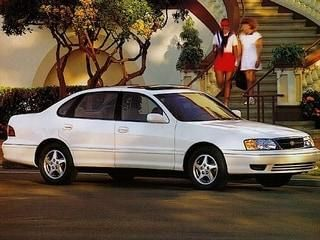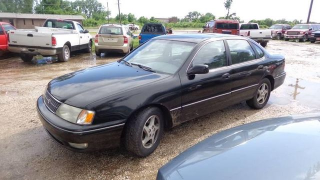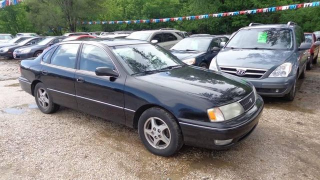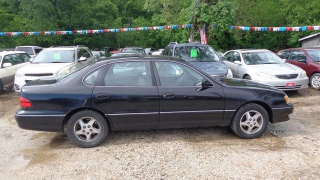The Good
The 1998 Toyota Avalon offers a smooth V6 performance, legendary reliability, and a remarkably comfortable, quiet, and spacious interior. Its conservative design has aged gracefully. Practical buyers appreciate its robust engineering, excellent fuel efficiency for its class, and outstanding long-term value. Emotionally, it provides peace of mind, a sense of secure family transport, and dependable, effortless journeys, making it a cherished choice.
The Bad
Known weaknesses for the 1998 Toyota Avalon include age-related wear on suspension components like struts and bushings, which can lead to a less refined ride. Critical timing belt replacement is often overlooked. Minor electrical quirks, such as fading radio displays or power window motor failures, can occur. Rust, depending on the climate, is also a consideration for these older models.
1998 Toyota Avalon: Quick Overview
The 1998 Toyota Avalon was available with a single, highly regarded powertrain combination, focusing on smooth and reliable operation.
- Engine Options: The sole engine offered was a 3.0-liter DOHC (Dual Overhead Cam) 24-valve V6 engine, internally known as the 1MZ-FE. This engine was paired exclusively with a 4-speed automatic transmission.
- Horsepower: This V6 engine produced 194 horsepower at 5200 rpm, providing ample power for daily driving and highway cruising.
- Torque: It generated 201 lb-ft of torque at 4400 rpm, contributing to its smooth acceleration.
- Fuel Economy: EPA estimated fuel economy for the 1998 Avalon was approximately 19-20 MPG in the city and 26-29 MPG on the highway, which was respectable for a full-size sedan of its era.
- 0-60 Times: The 1998 Avalon could accelerate from 0 to 60 mph in roughly 8.0 to 8.5 seconds, positioning it as adequately powered but not overtly sporty.
- Towing Capacity: The Toyota Avalon was not primarily designed for towing. While some sources might suggest a minimal capacity (often around 1,000 to 1,500 pounds for light utility), it's generally not recommended for significant towing due to its unibody construction and focus on passenger comfort.
- Trim-Level Features:
- Avalon XL: This base trim was well-equipped, featuring standard power windows, power door locks, power side mirrors, air conditioning, cruise control, a tilt steering wheel, and an AM/FM stereo with cassette player. It provided a comfortable and convenient experience without excessive frills.
- Avalon XLS: The upscale XLS trim built upon the XL's features, adding more premium amenities. Standard features included automatic climate control for enhanced comfort, alloy wheels for a more refined look, a premium audio system, a power-adjustable driver's seat, and remote keyless entry. Leather upholstery was a very popular option on the XLS, as were a power moonroof and a multi-disc CD changer, further elevating its luxury appeal. Many XLS models also came with anti-lock brakes (ABS) as standard, whereas it was often optional on the XL.
1998 Toyota Avalon Specifications
Vehicle Information
| Year | 1998 |
| Make | Toyota |
| Model | Avalon |
| Trim | - |
| Style | - |
| Type | Sedan |
| Category | Compact Car |
Manufacturing Details
| Made In | United States |
| Manufacturing City | GEORGETOWN |
Dimensions
| Doors | 4-Door |
| Curb Weight | - |
| Gross Vehicle Weight Rating | - |
| Overall Height | - |
| Overall Length | - |
| Overall Width | - |
| Wheelbase Length | - |
| Standard Seating | - |
Engine & Performance
| Engine | 1MZ-FE |
| Engine Size | 3L |
| Engine Cylinders | 6 |
| Transmission | Automatic 4-Speed |
| Transmission Type | Automatic |
| Transmission Speeds | 4-Speed |
| Drivetrain | Front-Wheel Drive |
Additional Features
| Anti-Brake System | - |
| Steering Type | - |
Pricing
| Manufacturer Suggested Retail Price (MSRP) | - |
| Invoice Price | - |
| Delivery Charges | - |
Vehicle History Report
Specifications
History
Events
History Check
Check
Check
Check
Check
Listings
Recalls
Check
Analysis
What Problems Does the 1998 Toyota Avalon Have?
Another frequently reported problem involves suspension components. Over two decades of use, front and rear struts, control arm bushings, and sway bar links inevitably wear out. This can lead to a "clunking" noise over bumps, a mushy ride, or uneven tire wear. Replacing these components can significantly refresh the vehicle's ride quality but represents a notable maintenance cost.
Minor electrical issues are not uncommon. Fading backlights on the climate control display or radio, intermittent power window motor operation, and issues with the power antenna are often reported. While generally not immobilizing, these can be frustrating. Brake components, such as warped rotors or sticking calipers, are also standard wear items that might need attention.
Regarding recalls for the 1998 model year specifically, major safety recalls would have been addressed long ago. However, it's always prudent for prospective buyers to check the NHTSA website for any outstanding recalls by VIN. Common recalls across the first-generation Avalon involved issues like daytime running lights, steering components, or airbag systems. For the 1998 model, the primary long-term reliability concern shifts from manufacturing defects to age-related wear and the diligence of previous owners' maintenance, particularly concerning the timing belt and suspension components.
How long will the 1998 Toyota Avalon last?
Over time, the main weaknesses include the aforementioned suspension component wear (struts, bushings), which can degrade ride quality. Interior plastics and upholstery may show wear and tear, and minor electrical glitches, like instrument cluster bulb failures, can arise. Rust can also become a factor in regions with harsh winters. However, the core mechanicals are typically robust, making it a very long-lasting vehicle when cared for.
What Technology & Safety Features are Included?
Built-in Tech & Entertainment:
Standard equipment typically included an AM/FM radio with a cassette player. The upscale XLS trim or optional packages often added a premium audio system, which might have included a multi-disc CD changer, usually mounted in the trunk. Automatic climate control was a significant "tech" feature in the XLS, offering more precise temperature management than the manual controls in the XL. Power-operated windows, door locks, and side mirrors were standard across both trims, as was cruise control. Driver information was conveyed via a traditional analog gauge cluster, without any multi-function digital displays found in contemporary cars.
Driver-Assistance Features:
Modern driver-assistance technologies like adaptive cruise control, lane-keeping assist, blind-spot monitoring, or automatic emergency braking were nonexistent in vehicles of this vintage. The Avalon's "assistance" was limited to basic power steering and anti-lock brakes (ABS).
Safety Features:
Safety features for the 1998 Avalon focused on passive restraints and fundamental braking systems.
- Airbags: Dual front airbags (for driver and front passenger) were standard. Side airbags were not available in the first-generation Avalon.
- Brakes: Anti-lock Braking System (ABS) was optional on the XL trim and often standard on the XLS, providing improved stopping performance under hard braking or slippery conditions.
- Seatbelts: Three-point seatbelts for all outboard occupants and seatbelt pretensioners for the front seats were standard.
- Child Safety: LATCH (Lower Anchors and Tethers for Children) systems were not yet standardized, but the Avalon did provide rear child seat tether anchors.
Crash-Test Ratings:
The 1998 Toyota Avalon generally performed well in crash tests for its time:
- NHTSA (National Highway Traffic Safety Administration):
- Frontal Crash Test: The Avalon received 4 out of 5 stars for the driver and 5 out of 5 stars for the front passenger, indicating good protection in a head-on collision.
- Side Impact Crash Test: It earned 4 out of 5 stars for front occupant protection and 3 out of 5 stars for rear occupant protection. This was without the benefit of modern side-impact airbags.
- IIHS (Insurance Institute for Highway Safety): While specific IIHS ratings for such an older model are less uniformly available in modern databases, the first-generation Avalon was generally considered a robust and safe vehicle in its class during its production years.
What Colors Options are Available?
1998 Toyota Avalon Prices and Market Value
However, due to its legendary reliability and robust build, its depreciation flattened out considerably over the long term. Today, its value is less about depreciation curves and more about its utilitarian worth and perceived reliability. Factors affecting current resale value include rust, major mechanical issues (especially an unserviced timing belt), accident history, and the overall cosmetic condition of both the interior and exterior. A documented service history significantly boosts its value.
1998 Toyota Avalon Cost of Ownership
1998 Toyota Avalon Fuel Efficiency
1998 Toyota Avalon Safety Rating
NHTSA
1998 Toyota Avalon Insurance
reasonable repair costs.
How Does the 1998 Toyota Avalon Compare to Other Sedan?
Performance: The Avalon's 3.0L V6 offered smooth, adequate power, similar to the Honda Accord V6 and Nissan Maxima, though it was less sporty than the Maxima's "4-Door Sports Car" persona. It generally outperformed the base engines of its American rivals and was on par with their V6 options, offering a more refined power delivery than many.
Features: Feature-wise, the Avalon's XL and XLS trims were well-equipped for the era, offering standard power amenities, air conditioning, cruise control, and optional premium audio and leather. It was comparable to its Japanese rivals and often felt more solidly built and refined than its domestic counterparts. While a Ford Taurus or Chevy Lumina might have offered similar features, the Toyota's execution often felt more upscale and durable.
Reliability: This is where the Avalon truly shined. Its legendary Toyota reliability often surpassed that of all its rivals, particularly the American models which were notorious for electrical issues and premature component failures in that era. The Honda Accord and Nissan Maxima were also reliable but arguably not to the same "bulletproof" degree as the first-generation Avalon's powertrain. This reliability directly translates to lower long-term ownership costs.
Price: New, the Avalon was competitively priced with its Japanese rivals and slightly above some domestic options. In the current used market, a well-maintained Avalon often commands a slightly higher price than a comparable Ford Taurus or Chevrolet Lumina of the same vintage, primarily due to its superior reliability and longevity. It typically fetches a similar, if not slightly lower, price than a well-kept Honda Accord V6 or Nissan Maxima.
Alternatives:
- Similar Alternative: A 1998 Honda Accord V6 offers a slightly sportier drive with comparable, though arguably not superior, reliability.
- Alternative for More Luxury/Space: A 1998 Buick LeSabre or Park Avenue provides even greater interior space and a softer ride, but may come with higher long-term maintenance costs and less renowned reliability than the Toyota.
- Alternative for Sportiness: A 1998 Nissan Maxima offers a more engaging driving experience, though its reliability, while good, might not quite match the Avalon's reputation.
Final Verdict: Is the 1998 Toyota Avalon a Good Sedan?
It is absolutely worth buying as a used vehicle, provided you find one in good condition with a documented maintenance history. Specifically, look for examples where the timing belt has been replaced. The XLS trim is recommended for its added comfort features like automatic climate control and often leather upholstery. Avoid neglected cars, as even a reliable Avalon can become a money pit if deferred maintenance is extensive. For its age and price point, it remains one of the smartest used car purchases for practicality and longevity.



